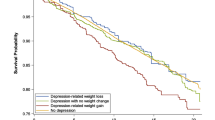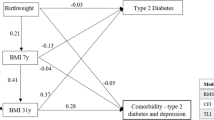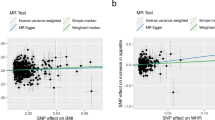Abstract
Objective:
This study concerns the question of whether obese subjects in a community sample experience depression in a different way from the nonobese, especially whether they overeat to the point of gaining weight during periods of depression.
Design:
A representative sample of adults was interviewed regarding depression and obesity.
Subjects:
The sample consisted of 1396 subjects whose interviews were studied regarding relationships between obesity and depression and among whom 114 had experienced a major depressive episode at some point in their lives and provided information about the symptoms experienced during the worst or only episode of major depression.
Measurements:
The Diagnostic Interview Schedule (DIS) was used to identify major depressive episodes. Information was also derived from the section on Depression and Anxiety (DPAX) of the Stirling Study Schedule. Obesity was calculated as a body mass index >30. Logistic regressions were employed to assess relationships, controlling for age and gender, by means of odds ratios and 95% confidence intervals.
Results:
In the sample as a whole, obesity was not related to depression although it was associated with the symptom of hopelessness. Among those who had ever experienced a major depressive episode, obese persons were 5 times more likely than the nonobese to overeat leading to weight gain during a period of depression (P<0.002). These obese subjects, compared to the nonobese, also experienced longer episodes of depression, a larger number of episodes, and were more preoccupied with death during such episodes.
Conclusions:
Depression among obese subjects in a community sample tends to be more severe than among the nonobese. Gaining weight while depressed is an important marker of that severity. Further research is needed to understand and possibly prevent the associations, sequences and outcomes among depression, obesity, weight gain and other adversities.
This is a preview of subscription content, access via your institution
Access options
Subscribe to this journal
Receive 12 print issues and online access
$259.00 per year
only $21.58 per issue
Buy this article
- Purchase on Springer Link
- Instant access to full article PDF
Prices may be subject to local taxes which are calculated during checkout
Similar content being viewed by others
References
Muncie W . Psychobiology and Psychiatry: A Textbook of Normal and Abnormal Human Behavior. Mosby Press: St Louis, 1939.
American Psychiatric Association. Diagnostic and Statistical Manual of Mental Disorders 3rd edn. American Psychiatric Association: Washington DC, 1980.
American Psychiatric Association. Diagnostic and Statistical Manual of Mental Disorders 4th edn. American Psychiatric Association: Washington DC, 1994.
Bernstein JG . Psychotropic drug induced weight gain: mechanisms and management. Clin Neuropharmacol 1988; 11 (Suppl): S194–S206.
Wurtman RJ, O’Rourke D, Wurtman JJ . Nutrient imbalances in depressive disorders: possible brain mechanisms. Ann N Y Acad Sci 1989; 575: 75–82.
Nierenberg AA, Pava JA, Clancy K, Rosenbaum JF, Fava M . Are neurovegetative symptoms stable in relapsing or recurrent atypical depressive episodes? Biol Psychiatry 1996; 40: 691–696.
Carter JD, Joyce PR, Mulder RT, Luty SE, McKenzie J . Gender differences in the presentation of depressed outpatients: a comparison of descriptive variables. J Affect Disord 2000; 61: 59–67.
Christensen L, Pettijohn L . Mood and carbohydrate cravings. Appetite 2001; 36: 137–145.
Parker G, Roy K, Mitchell P, Wilhelm K, Malhi G, Hadzi-Pavlovic D . Atypical depression: a reappraisal. Am J Psychiatry 2002; 159: 1470–1479.
Benazzi F . Testing atypical depression definitions. Int J Methods Psychiatr Res 2005; 14: 82–91.
Stunkard AJ, Fernstrom MH, Price A, Frank E, Kupfer DJ . Direction of weight change in recurrent depression: consistency across episodes. Arch Gen Psychiatry 1990; 47: 857–860.
Stunkard AJ, Faith MS, Allison KC . Depression and obesity. Biol Psychiatry 2003; 54: 330–337.
Papakostas GI, Petersen T, Losifescu DV, Burns AM, Nierenberg AA, Alpert JE et al. Obesity among outpatients with major depressive disorder. Int J Neuropsychopharmacol 2004; 8: 59–63.
Ross C . Overweight and depression. J Health Soc Behav 1994; 35: 63–79.
Carpenter KM, Hasin DS, Allison DB, Faith MS . Relationships between obesity and DSM-IV major depressive disorder, suicide ideation, and suicide attempts: results from a general population study. Am J Public Health 2000; 90: 251–257.
Roberts RE, Kaplan GA, Shema SJ, Strawbridge WJ . Are the obese at greater risk for depression? Am J Epidemiol 2000; 152: 163–170.
Faith MS, Matz PE, Jorge MA . Obesity-depression associations in the population. J Psychosom Res 2002; 53: 935–942.
Onyike CU, Crum RM, Lee HB, Lyketsos CG, Eaton WW . Is obesity associated with major depression? Results from the Third National Health and Nutrition Examination Survey. Am J Epidemiol 2003; 158: 1139–1147.
Roberts RE, Deleger S, Strawbridge WJ, Kaplan GA . Prospective association between obesity and depression: evidence from the Alameda County Study. Int J Obes Relat Metab Disord 2003; 27: 514–521.
McIntyre RS, Konarski JZ, Wilkins K, Soczynska JK, Kennedy SH . Obesity in bipolar disorder and major depressive disorder: results from a National Community Health Survey on mental health and well-being. Can J Psychiatry 2006; 51: 274–280.
Horwath E, Johnson J, Weissman MM, Hornig CD . The validity of major depression with atypical features based on a community study. J Affect Disord 1992 (2); 26: 117–125.
Levitan RD, Lesage A, Parikh SV, Goering P, Kennedy SH . Reversed neurovegetative symptoms of depression: a community study of Ontario. Am J Psychiatry 1997; 154: 934–940.
Sullivan PF, Kessler RC, Kendler KS . Latent class analysis of lifetime depressive symptoms in the National Comorbidity Survey. Am J Psychiatry 1998; 155: 1398–1406.
Angst J, Gamma A, Sellaro R, Zhang H, Merikangas K . Toward validation of atypical depression in the community: results of the Zurich cohort study. J Affect Disord 2002; 72: 125–138.
Matza LS, Revicki DA, Davidson JR, Stewart JW . Depression with atypical features in the National Comorbidity Survey: classification, description and consequences. Arch Gen Psychiatry 2003; 60: 817–826.
Kendler KS, Eaves LJ, Walters EE, Neale MC, Heath AC, Kessler RC . The identification and validation of distinct depressive syndromes in a population-based sample of female twins. Arch Gen Psychiatry 1996; 53: 391–399.
Leighton AH . My Name Is Legion: The Stirling County Study of Psychiatric Disorder and Sociocultural Environment, vol. 1 Basic Books Inc.: New York, 1959.
Murphy JM . Continuities in community-based psychiatric epidemiology. Arch Gen Psychiatry 1980; 37 (11): 1215–1223.
Murphy JM, Monson RR, Laird NM, Sobol AM, Leighton AH . A 40-year perspective on the prevalence of depression: the Stirling County Study. Arch Gen Psychiatry 2000; 57: 209–215.
Robins LN, Helzer JE, Croughan J, Ratcliff KS . National Institute of Mental Health Diagnostic Interview Schedule: its history, characteristics and validity. Arch Gen Psychiatry 1981; 38: 381–389.
Robins LN, Regier DA (eds). Psychiatric Disorders in America: the Epidemiologic Catchment Area Study. The Free Press: New York, 1991.
Murphy JM, Monson RR, Laird NM, Sobol AM, Leighton AH . Identifying depression and anxiety in a forty-year epidemiologic investigation: the Stirling County Study. Int J Method Psychiatr Res 1998; 7: 89–109.
Murphy JM, Neff RK, Sobol AM, Rice JX, Olivier DC . Computer diagnosis of depression and anxiety: the Stirling County Study. Psychol Med 1985; 15: 99–112.
National Heart, Lung and Blood Institute. Clinical Guidelines for the Identification, Evaluation, and Treatment of Overweight and Obesity in Adults: The Evidence-Report. National Heart, Lung and Blood Institute: Bethesda, MD, 1998.
Hosmer DW, Lemeshow S . Applied Logistic Regression, 2nd edn. John Wiley & Sons: New York, 2000.
Flegal KM, Carroll MD, Ogden CL, Johnson CL . Prevalence and trends in obesity among US adults, 1999–2000. JAMA 2002; 288: 1723–1727.
Katzmarzyk PT . The Canadian obesity epidemic: an historical perspective. Obes Res 2002; 10: 666–674.
Weissman MM, Bruce ML, Leaf PJ, Florio LP, Holzer C . Affective disorder. In: Robins LN, Regier DA (eds). Psychiatric Disorders in America: The Epidemiologic Catchment Area Study. The Free Press: New York, 1991, pp 53–80.
Bland RC, Orn H, Newman SC . Lifetime prevalence of psychiatric disorders in Edmonton. Acta Psychiatr Scand Suppl 1988; 338: 24–32.
Murphy JM, Monson RR, Laird NM, Sobol AS, Leighton AH . A comparison of diagnostic interviews for depression in the Stirling County Study: challenges for psychiatric epidemiology. Arch Gen Psychiatry 2000; 57: 230–236.
Gortmaker SL, Must A, Perrin JM, Sobol AM, Dietz WH . Social and economic consequences of overweight in adolescence and young adulthood. N Engl J Med 1993; 329: 1008–1012.
Murray CJL, Lopez AD . Global mortality, disability, and the contribution of risk factors: Global Burden of Disease Study. Lancet 1997; 349: 1436–1442.
Allison DB, Fontaine KR, Manson JE, Stevens J, VanItallie TB . Annual deaths attributable to obesity in the United States. JAMA 1999; 282: 1530–1538.
Manson JE, Bassuk SS . Excess weight and mortality: a fresh look at its high toll. JAMA 2003; 289: 229–230.
Yusuf S, Hawken S, Ounpuu S, Dans T, Avezum A, Lanas F et al. Effect of potentially modifiable risk factors associated with myocardial infarction in 52 countries (the INTERHEART study); case–control study. Lancet 2004; 364: 937–952.
Faith MS, Matz PE, Jorge MA . Obesity–depression associations in the population. J Psychosom Res 2002; 53: 935–942.
Beck AT, Steer RA, Kovacs M, Garrison B . Hopelessness and eventual suicide: a 10-year prospective study of patients hospitalized with suicidal ideation. Am J Psychiatry 1985; 142: 559–563.
Beck AT, Brown G, Berchick RJ, Stewart BL, Steer RA . Relationship between hopelessness and ultimate suicide: a replication with psychiatric outpatients. Am J Psychiatry 1990; 147: 190–195.
Glassman AH, Helzer JE, Covey LS, Cottler LB, Stetner F, Tipp JE et al. Smoking, smoking cessation, and major depression. JAMA 1990; 264: 1546–1549.
Maier W, Merikangas K . Co-occurrence and co-transmission of affective disorders and alcoholism in families. Br J Psychiatry 1996; 168: 93–100.
Kessler RC, Crum RM, Warner LA, Nelson CB, Schulenberg J, Anthony JC . Lifetime co-occurrence of DSM-III-R alcohol abuse and dependence with other psychiatric disorders in the National Comorbidity Survey. Arch Gen Psychiatry 1997; 54: 313–321.
Khantzian EJ . The self-medication hypothesis of substance-use disorders: a recommendation and recent application. Harv Rev Psychiatry 1997; 4: 231–244.
Murphy JM, Horton NJ, Monson RR, Laird NM, Sobol AM, Leighton AH . Cigarette smoking in relation to depression: historical trends from the Stirling County Study. Am J Psychiatry 2003; 160: 1663–1669.
Murphy JM, Olivier DC, Sobol AM, Monson RR, Leighton AH . Diagnosis and outcome: depression and anxiety in a general population. Psychol Med 1986; 16: 117–126.
Murphy JM, Monson RR, Olivier DC, Sobol AM, Leighton AH . Affective disorders and mortality: a general population study. Arch Gen Psychiatry 1987; 44: 473–480.
Acknowledgements
The research reported here was supported by grant R01 MH39576-23 from the National Institute of Mental Health of the National Institutes of Health (Dr Murphy). Grateful acknowledgement is made to Patricia Merritt, Ellen Krystofik and Julie Burns for field management and data processing and additionally to Julie Burns for help with the literature review.
Author information
Authors and Affiliations
Corresponding author
Rights and permissions
About this article
Cite this article
Murphy, J., Horton, N., Burke, J. et al. Obesity and weight gain in relation to depression: findings from the Stirling County Study. Int J Obes 33, 335–341 (2009). https://doi.org/10.1038/ijo.2008.273
Received:
Revised:
Accepted:
Published:
Issue Date:
DOI: https://doi.org/10.1038/ijo.2008.273
Keywords
This article is cited by
-
The psychological legacy of past obesity and early mortality: evidence from two longitudinal studies
BMC Medicine (2023)
-
Obesity, antenatal depression, diet and gestational weight gain in a population cohort study
Archives of Women's Mental Health (2016)
-
Quality of life as a mediator in the association between body mass index and negative emotionality in overweight and obese non-clinical sample
Eating and Weight Disorders - Studies on Anorexia, Bulimia and Obesity (2015)
-
Overweight/Obese Patients Referring to Plastic Surgery: Temperament and Personality Traits
Obesity Surgery (2013)
-
Obesity Disparities in Preventive Care: Findings From the National Ambulatory Medical Care Survey, 2005–2007
Obesity (2012)



